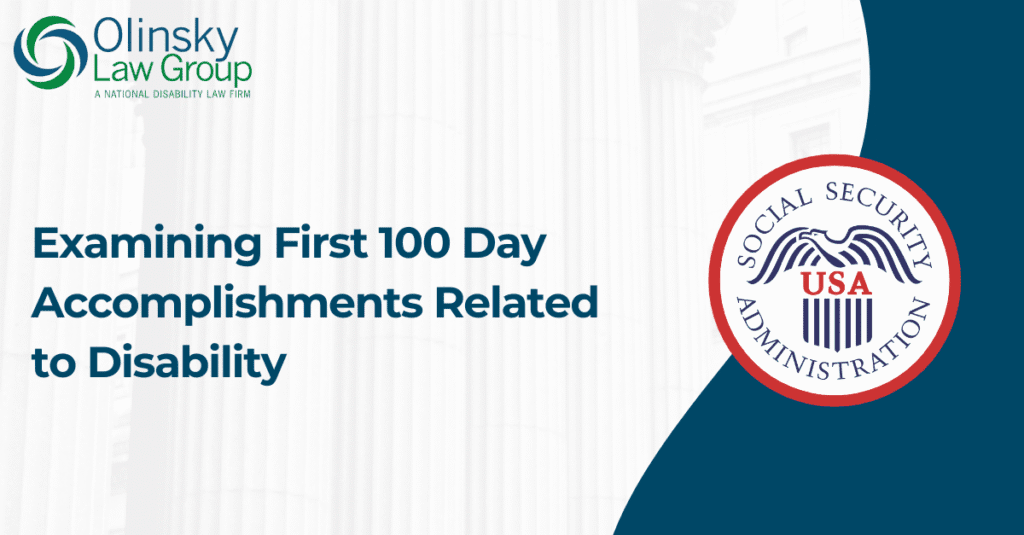Examining Social Security’s First 100 Day Accomplishments Related to Disability

On April 29th, 2025, the Social Security Administration (SSA) publicly announced several accomplishments the agency considers to be improvements during the first 100 days of the Trump Administration. The agency references many items from their agenda, and highlights the focus remaining on customer service, reducing fraud, and more. Of the various accomplishments cited, the Olinsky Law Group team identifies a few of SSA’s considered improvements related to the disability determination process.
Modernized Platform for National 800 Number:
SSA is in the process of launching a technological innovation for all its field offices, designed to modernize the National 800 Number. SSA states, “Once fully implemented, this platform will allow the agency to better manage calls to its field offices nationwide while providing more self-service options for customers, including artificial intelligence (AI)-enabled enhancements.” Enhancing the National 800 Number is one of the many stated improvements that addresses customer service, as the current daily call volume is nearly 400,000 calls, and the answer rate is below 50%.
Emphasis on Health Information Technology (Health IT):
The Health Information Technology (Health IT) program is meant for SSA to obtain medical records from providers quicker. With emphasis on efficiency, their focus to expand this program includes the development of more outreach and partnerships with health care organizations. “This initiative not only expedites the benefits process for applicants but also saves taxpayer money by reducing the costs associated with collecting medical records, as each year SSA receives over 3 million new applications for disability benefits and spends over $500 million dollars to collect medical records for applicants,” SSA says. A current concern with the agency is the evident long wait times experienced when applying for benefits. Considering this concern, one of the agency’s many asserted goals is to be more efficient and produce faster determinations. Revitalizing this program is ultimately another approach intended to address those long wait times and efficiency.
Introduction of Hearing Recording and Transcriptions (HeaRT) System:
The Hearing Recording and Transcriptions (HeaRT) system is reported to be an upgrade used to transcribe and record during disability hearings through the assistance of AI. According to SSA, the HeaRT system “replaces an antiquated and bulky hardware system in each hearing office with a software only solution that records and produces transcripts for each case at the hearings level to ensure due process.” It is viewed as an improvement in efficiency as it works to provide more accurate automated transcripts. SSA announced this will contribute to better customer service because the system supports all hearing formats (in-person, telephone and video). As a result, they anticipate this innovation will decrease delays and cancellations due to equipment failure or technical difficulties, enforcing more timely hearings. With long wait times at the hearing level, this adds another technological system and element that is directed toward customer service and efficiency to improve wait times.
Publishing of SSA Performance Data:
In their announcement, SSA indicated their belief that communication and transparency efforts have continued to improve. The agency stated, “In keeping with President Trump’s belief that good government must serve the People, SSA has regularly published updates on agency operations across all of its communications channels and will continue to do so.” SSA routinely reports its performance figures to the public, providing the ability to analyze processing times of the different levels throughout the determination process. Examining SSA performance grants representatives and the public the opportunity to compare figures from previous months or years, and gain insight into factors including processing times and data regarding the National 800 Number. Current wait times are undoubtedly high throughout the entire determination process, nonetheless, according to SSA, releasing this data is another significant contribution to customer service dedication.
Final Insights:
Upon reviewing the claimed accomplishments, a key insight is the evolution of technology and AI within the industry. The technological advancements are intended to enhance many items on SSA’s agenda including customer service and efficiency, ultimately improving wait times. In particular, the current wait times are remarkably high, with the average disability determination processing time at 232 days, and doubling since 2018. Examining the performance data frequently will allow disability representatives to review the agency’s progress regarding wait times throughout 2025. In addition to examining SSA performance, disability representatives, including the Olinsky Law Group team, will continue to evaluate this new technology, and how the developments affect the disability determination process throughout 2025.
To read the press release and list of improvements, navigate here.
 Contact Us: 1-888-WIN-SSDISM
Contact Us: 1-888-WIN-SSDISM  info@windisability.com
info@windisability.com